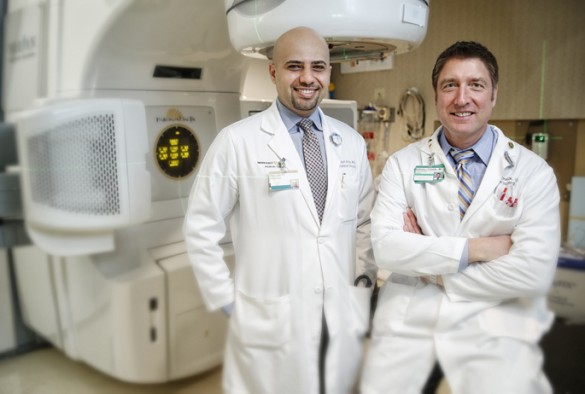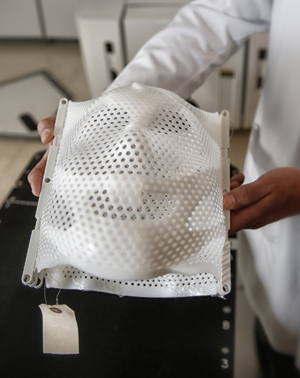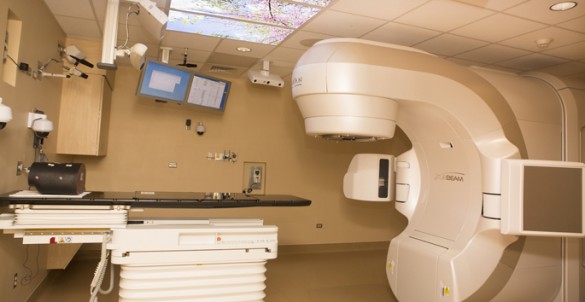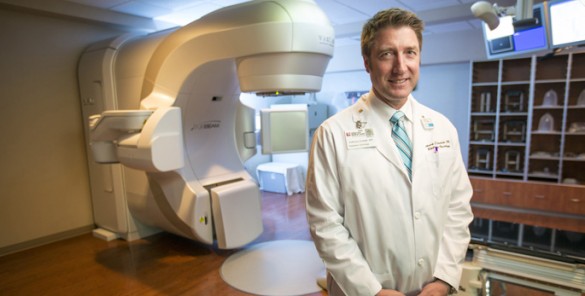
Vanderbilt University Medical Center’s stereotactic radiosurgery equipment was the first of its kind in Middle Tennessee in 2009. Now, a newly organized Stereotactic Radiosurgery Center is making it easier for patients to receive this cutting-edge treatment.
Stereotactic radiosurgery is a technique that uses precise beams of radiation to destroy cancer tumors.
“The idea is to treat the tumor with a very high dose of radiation but spare the rest of the tissue surrounding it,” said Albert Attia, M.D, assistant professor of Radiation Oncology and leader of the new center.
Radiosurgery was first developed in the 1950s for malignant brain tumors but is now indicated for benign tumors, malformations of blood vessels in the brain (arteriovenous malformation) and functional disorders like trigeminal neuralgia and tremors. It is also in the early stages of use for spinal tumors.

“Most applications are in the brain,” Attia said. “Sometimes patients can’t tolerate surgery or their tumor is in a place you can’t cut. We also use radiosurgery frequently for brain metastasis, where tumors are spread all over the brain and surgery would be too morbid.”
Patients are fitted with a tight plastic mesh mask that holds the head in place without the need for an invasive frame. A combination of CT and MRI scans use the mask to precisely calibrate the placement of the beams of radiation within millimeter accuracy. Treatment time can range from 30-90 minutes, with very few side effects.
“The beams come in from multiple angles with different dose weighting. We optimize the settings to deliver the most radiation to the tumor and spare the other critical structures,” Attia said.
The new Stereotactic Radiosurgery Center takes a multi-disciplinary approach to enhance treatment for patients.
“We wanted to gather the troops because it’s always better to have a multi-disciplinary approach. With the radiation oncologists and neurosurgeons working together, we can create better treatment plans for each patient,” Attia said.
The Center’s team includes Anthony Cmelak, M.D., professor of Radiation Oncology, Lola Chambless, M.D., assistant professor of Neurosurgery, Kyle Weaver, M.D., assistant professor of Neurosurgery, Reid Thompson, M.D., William F. Meacham Professor and chair of Neurosurgery, J Mocco, M.D., M.S., associate professor of Neurological Surgery, Michael Froehler, M.D., Ph.D., assistant professor of Neurology and Neurosurgery, and George Wanna, M.D., assistant professor of Otolaryngology
Key to the new Center is patient coordinator Shonte Johnson, who helps patients arrange the many clinic appointments and scans needed before radiosurgery.
“Many of our patients are coming from hours away, and we don’t want them to have to make multiple visits. Shonte sets it up so they can see their doctors on one day and get all the scans they need the next day. She’s our point person and makes their experience so much easier,” Attia said.
Organizing the new center will also facilitate more clinical trials to advance the radiosurgery field.
“We want Vanderbilt to be a powerhouse in the stereotactic world and offer the absolute best treatment to patients,” Attia said.















